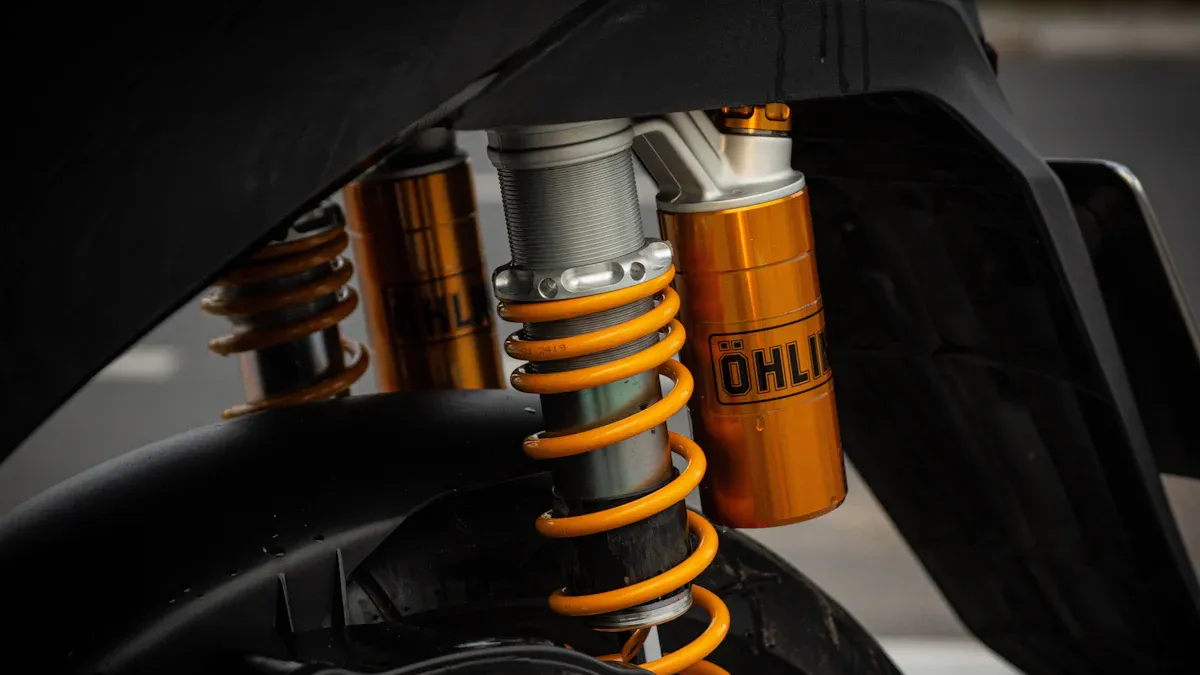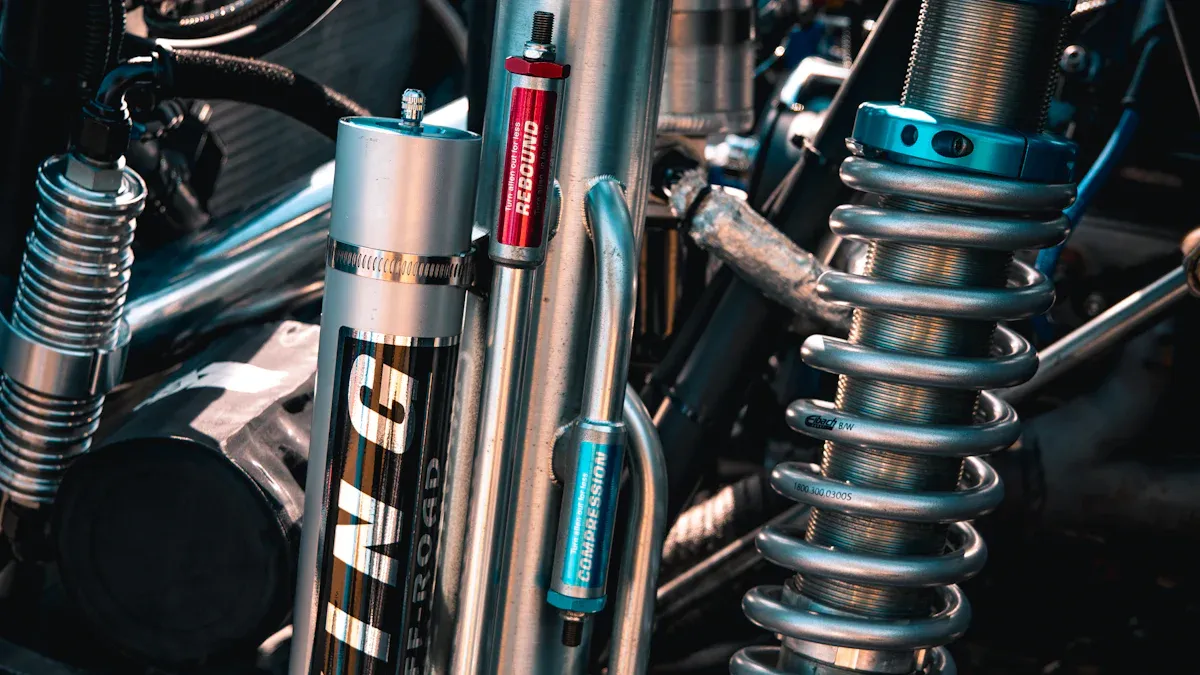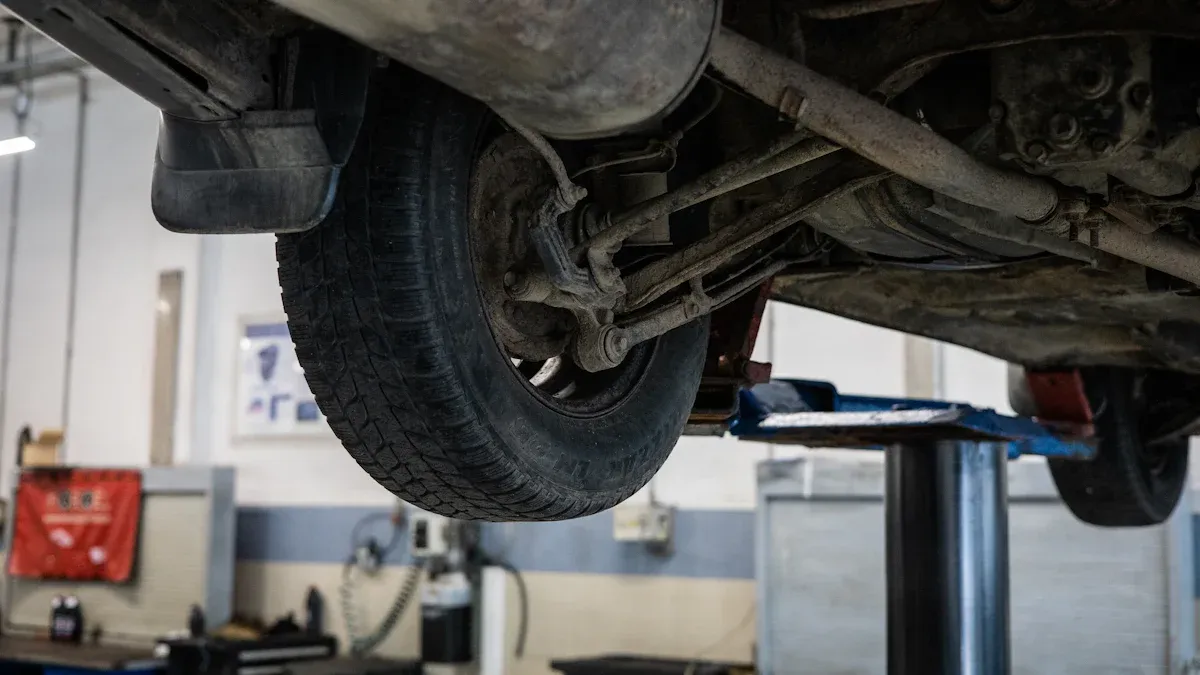
You experience greater control and comfort on the road when your vehicle is equipped with shock absorbing springs. These shock absorbing springs effectively reduce the impact of bumps and potholes, helping your suspension maintain optimal tire contact with the road. Studies show that shock absorbing springs lower vibrations and make your ride smoother, which can decrease accident risk.
- Shock absorbing springs and shock absorbers work together to dampen road impact, providing a smoother ride.
- The global market for shock absorbing springs and shock absorbers reached $12.52 billion in 2020 and is projected to grow to $21.07 billion by 2030.
- Advances in technology now allow shock absorbing springs to make real-time adjustments, further improving comfort and control.
How Shock Absorbing Springs Improve Suspension Stability

The Science Behind Shock Absorbing Springs
You rely on shock absorbing springs to keep your suspension system working smoothly. These springs use scientific principles to control movement and absorb energy. When your vehicle hits a bump, the springs compress and expand. This action helps convert kinetic energy into heat, which then escapes into the air.
- Shock absorbers act like oil pumps. A piston moves against hydraulic fluid inside the shock absorber.
- The fluid passes through tiny holes, slowing down the piston and controlling how fast the suspension moves.
- Most of the energy from bumps turns into heat inside the fluid, which then dissipates.
Materials play a big role in how well shock absorbing springs perform. Manufacturers use low carbon-structural steel and chrome vanadium steel for strength and flexibility. Some designs use natural rubber for lighter springs, especially in motorcycles. Engineers test wire diameter and coil radius to find the best balance between stiffness and comfort. You also see advanced materials like Spring Steel, Phosphor bronze, Beryllium Copper, and Titanium alloy. These materials go through structural and modal analysis to make sure they work well in your suspension system.
Tip: Choosing springs made from high-quality materials can make your suspension upgrades last longer and perform better.
Maintaining Tire Contact and Traction
Shock absorbing springs help your tires stay in contact with the road. This is important for safety and handling. When you drive over rough terrain, the springs absorb shocks and vibrations. You feel less bounce, and your ride becomes smoother.
- Springs increase ground contact, which improves grip and traction.
- You get better stability and control, especially when turning or braking.
- Springs minimize body roll, so your vehicle stays balanced during sharp maneuvers.
Here is a table showing how shock absorbing springs improve traction under different driving conditions:
| Aspect | Evidence |
|---|---|
| Improved Stability | Springs maintain optimal tire contact, minimizing body roll and enhancing balance during driving. |
| Enhanced Cornering Ability | Better tire grip reduces risks of understeering and oversteering, improving overall handling. |
| Better Braking Performance | Optimizes tire contact during braking, resulting in shorter stopping distances and improved control. |
| Increased Acceleration | Enables better power transfer, leading to quicker acceleration and a more responsive ride. |
You benefit from progressive rate springs, which adjust stiffness based on load. This means your suspension system adapts to uneven surfaces, giving you more traction. High-performance spring materials offer durability and less weight, which also helps with traction. Some vehicles use active suspension systems that change settings in real time, so you always get the best grip. Air spring technology lets you adjust stiffness and ride height, making your suspension upgrades even more effective across different road conditions.
Note: Keeping your suspension system in good shape helps you stay safe and enjoy better handling every time you drive.
The Role of Shock Absorbing Springs in Suspension Systems
What Sets Shock Absorbing Springs Apart
You notice a difference in your vehicle’s performance when you use shock absorbing springs instead of other types. These springs stand out because of their unique design and advanced materials. Manufacturers often use carbon and air in shock absorbing springs, which helps them absorb shocks more effectively. You get a smoother ride and better comfort compared to conventional coil springs or leaf springs.
| Type of Spring | Design Characteristics | Performance Characteristics |
|---|---|---|
| Shock Absorbing Springs | Made from alternative materials like carbon and air | Designed to absorb shocks and provide a smoother ride |
| Conventional Coil Springs | Typically made of steel, coiled in a spiral shape | Provides basic support and stability |
| Leaf Spring | Composed of multiple layers of metal | Offers high load capacity but less shock absorption |
| Air Springs | Uses air pressure for support | Adjustable ride height and comfort |
| Bump Stops | Designed to limit suspension travel | Prevents bottoming out during heavy impacts |
You see that shock absorbing springs focus on comfort and handling. Conventional coil springs give you basic support, but they do not absorb shocks as well. Leaf springs help with heavy loads, but you feel more bumps. Air springs let you adjust ride height, which improves comfort. Bump stops protect your suspension from damage during hard impacts.
Integration with Other Suspension Components
You benefit most when shock absorbing springs work together with other suspension parts. Springs act as the flexible link in the suspension system. They allow your vehicle’s frame and body to move smoothly over uneven surfaces. Coil springs compress and rebound to absorb bumps, keeping your wheels in contact with the road. Leaf springs use stacked steel strips to provide support.
Shock absorbers and springs work as a team. They absorb road shocks and vibrations, which is crucial for ride quality. You experience a smooth and comfortable journey because of this interaction. Springs support your vehicle’s weight and absorb road shocks. They maintain ride height and keep the frame steady while the tires follow the bumps.
When you invest in suspension upgrades, you improve handling and stability. You get better control, especially when driving on rough roads. Upgrades to shock absorbing springs enhance the performance of the entire suspension system. You notice improved comfort, better traction, and safer driving.
Tip: Regular maintenance of your suspension system helps you keep all components working together for the best results.
Real-World Benefits of Suspension Upgrades
Enhanced Comfort and Smoother Rides
You feel the difference when you invest in suspension upgrades. Shock absorbing springs play a key role in reducing vibrations and impacts from the road. Nonlinear asymmetrical shock absorbers improve comfort in passenger vehicles by lowering acceleration levels, which means you experience fewer jolts and bumps. These systems provide smoother and more progressive movement, both vertically and angularly.
Many drivers report improved ride quality and lasting performance after upgrading their suspension system. Mobility scooters with proper suspension absorb shocks and reduce vibrations, making rides smoother for older adults. You notice that your vehicle glides over uneven surfaces, keeping you comfortable even on long trips.
Tip: Upgrades to your suspension system can make daily commutes and long journeys much more pleasant.
Improved Handling and Safety
You gain better control and stability when you upgrade your suspension. Shock absorbing springs help your tires stay in contact with the road, which is crucial for steering and braking. If your suspension system wears out, you may see increased stopping distances and unpredictable vehicle behavior. A well-maintained suspension ensures quick and precise steering response, making emergency maneuvers safer.
You also benefit from reduced body roll and enhanced control. Advanced suspension upgrades, like Hendrickson’s Zero Maintenance Damping system, have transformed driver experiences by improving ride quality and reducing forces transmitted to trailers. This innovation eliminates traditional shock absorbers, leading to better handling and comfort. Drivers now request these systems for future orders because they improve safety and lower lifecycle costs.
| Condition | Improvement in Ride Comfort |
|---|---|
| Nonlinear and Parasitic Effects Neglected | 17.6% |
| Nonlinear and Parasitic Effects Considered | 8.3% |
Note: Upgrades to your suspension system can prevent fatigue and injury by minimizing exposure to vibrations.
Better Performance in Diverse Road Conditions
You notice the benefits of suspension upgrades when driving in different environments. Heavy-duty shock absorbing springs are essential for vehicles that tow heavy loads or travel off-road. Standard springs may not handle the extra stress, but upgraded suspension components provide durability and control under load.
Engineers use metrics like spring stiffness, damping coefficients, inertance, and sprung mass to evaluate suspension performance. For example:
| Parameter | Range of values |
|---|---|
| Spring stiffness of front suspension/(N/m) | 146,000–438,000 |
| Damping coefficient of front suspension/(N·s/m) | 20,210–60,630 |
| Inertance of front suspension/(kg) | 750–2,250 |
| Sprung mass | No load–full load |
The Sutong Bridge in China used spring-damper isolators to manage dynamic loads from earthquakes and typhoons. The design activated a snubbing type spring element during extreme conditions, reducing deck motions and improving structural integrity. You see that high-quality suspension upgrades can handle diverse and challenging road conditions, keeping you safe and comfortable.
Identifying When Shock Absorbing Springs Need Attention

Warning Signs of Worn or Damaged Springs
You depend on your suspension to keep your vehicle safe and comfortable. When shock absorbing springs start to wear out, you notice changes in how your car feels and sounds. Recognizing these signs early helps you avoid bigger problems and keeps your suspension working well.
- You feel uncomfortable rides where bumps seem much worse than before.
- Your vehicle bounces too much after hitting a bump.
- You hear clunking noises from underneath your car.
- The steering wheel feels shaky or loose.
- Your car leans to one side when parked.
- Tires show uneven wear patterns, like cupping or ridges.
- You have trouble steering or notice instability in handling.
- The car keeps bouncing for a long time after going over bumps.
- You hear rattling or grinding noises from the suspension.
If you see any of these warning signs, your suspension may need attention. Regular checks help you catch problems early and keep your suspension system in top shape.
Tip: Inspect your suspension at least once a year or every 12,000 miles. If you drive in harsh conditions, check it more often.
When to Consider Suspension Upgrades
You want your vehicle to perform its best, so knowing when to upgrade your suspension is important. Upgrades improve handling and comfort, especially if you notice problems or want better performance. You should look for visible oil leaks, excessive bouncing, uneven tire wear, and changes in handling or stopping distance.
When you decide to upgrade, consider these factors:
| Factor | Description |
|---|---|
| Fit | Make sure the springs match your vehicle model. |
| Spring Rate | Pick a rate that fits your driving style. Too stiff affects comfort, too soft affects handling. |
| Shock Absorber Match | Use shocks that work with your new springs for the best performance. |
You also need to think about valving, length, and whether you want gas charged or adjustable shocks. Premium shock absorbing springs offer better ride comfort, improved stability, and longer durability. They cost more, but you save money over time because they last longer and help with improving handling in many driving conditions.
Note: Upgrades to your suspension system give you better control, safety, and comfort. Choose quality parts for the best results.
Maximizing Suspension Performance with Quality Springs
Maintenance Tips for Longevity
You can extend the life of your suspension by following a few simple maintenance steps. Regular care helps your shock absorbing springs work better and last longer. Start by checking your tire pressure every month. Incorrect tire pressure puts extra strain on your suspension and can lead to uneven wear. Schedule wheel alignments every six months to keep your vehicle stable and prevent extra stress on the springs. Replace any worn parts right away. Delaying repairs can cause more damage to your suspension system.
Keep all suspension joints well-lubricated. Lubrication reduces friction and stops bushings and joints from wearing out too soon. Protect your suspension from corrosion, especially if you drive in areas with high humidity or road salt. Corrosion weakens metal springs and can lead to failure. Environmental factors like humidity and temperature changes also affect your springs. High humidity causes corrosion, while extreme temperatures can make rubber parts crack or harden.
Here is a table that shows key maintenance practices:
| Maintenance Practice | Description |
|---|---|
| Regular Inspections | Routine checks help you find issues early. |
| Proper Tire Pressure | Prevents uneven wear and reduces strain on suspension components. |
| Scheduling Wheel Alignments | Keeps your suspension stable and reduces tire wear. |
| Replacing Worn Parts Promptly | Stops further damage and keeps your suspension working well. |
| Keeping Suspension Joints Lubricated | Reduces friction and prevents early wear. |
| Protecting from Corrosion | Extends the life of your springs and other suspension parts. |
Tip: If you drive in harsh weather or on rough roads, check your suspension more often to keep your vehicle safe and comfortable.
Choosing the Right Shock Absorbing Springs
You need to pick the right shock absorbing springs for your vehicle to get the best performance and stability. Start by looking at your vehicle’s weight. Light vehicles use 2.0-inch shocks, which work well for street driving. Medium vehicles, like SUVs, need 2.5-inch shocks for better handling and comfort. Heavy vehicles or those used for racing need 3.0-inch shocks for maximum support.
Think about your driving conditions. If you drive off-road or carry heavy loads, choose springs designed for those uses. Make sure the springs fit your vehicle’s mounting points and match the piston rod diameter. Some springs come with different reservoir styles for better cooling and performance.
Here is a table to help you choose:
| Shock Size | Recommended Vehicle Weight | Application Type |
|---|---|---|
| 2.0″ | Up to 5,000 lbs | Light weight vehicles, street use |
| 2.5″ | 5,000 – 7,500 lbs | Medium vehicles, recreational/racing |
| 3.0″ | Over 7,500 lbs | Heavy vehicles, professional racing |
Different brands offer unique features. Rancho shocks focus on off-road performance and durability. Monroe shocks are affordable and easy to install, making them great for daily driving. Fox shocks offer high performance and adjustable settings for custom tuning.
Note: The right suspension upgrades improve your handling, comfort, and safety. Always choose quality springs that match your needs for the best results.
You depend on shock absorbing springs for a stable, comfortable, and safe driving experience. Regular inspection and timely upgrades help your suspension system work at its best.
- Routine maintenance improves vehicle performance and safety.
- Systematic inspections catch wear early, so you can replace parts before problems grow.
- Upgrading your suspension increases traction and stability, making rough roads easier to handle.
Max Auto Parts Co., Ltd. uses strict quality control and provides detailed inspection reports. Partner factories hold TS16949 certification, meeting global standards.
| Product Name | Rating | Review Summary |
|---|---|---|
| Gabriel Max Control Shocks | 5/5 | Excellent performance and ride quality |
| Gabriel Max Control Shocks | N/A | Improved ride back to like new |
Choosing Max means you get high-quality products and expert support for all your suspension needs.
FAQ
What are shock absorbing springs?
Shock absorbing springs help your vehicle handle bumps and rough roads. They absorb energy from impacts and keep your tires on the ground. You get a smoother, safer ride because these springs reduce vibrations and improve stability.
How often should you check your suspension springs?
You should inspect your suspension springs at least once a year or every 12,000 miles. If you drive on rough roads or in harsh weather, check them more often. Regular checks help you catch problems early.
Can you replace shock absorbing springs yourself?
You can replace shock absorbing springs if you have the right tools and experience. Many people choose professional help because the process requires lifting the vehicle and handling heavy parts. Safety always comes first.
What happens if you ignore worn springs?
If you ignore worn springs, your ride becomes rough and unsafe. You may notice more bouncing, poor handling, and uneven tire wear. Ignoring these signs can lead to bigger suspension problems and higher repair costs.
How do you choose the right shock absorbing springs for your vehicle?
You should match the spring size and type to your vehicle’s weight and driving needs. Use this table for quick reference:
| Vehicle Type | Recommended Spring Size |
|---|---|
| Light Car | 2.0″ |
| SUV/Medium Truck | 2.5″ |
| Heavy Truck/Race | 3.0″ |
Tip: Always check your vehicle manual or ask a suspension expert for advice.
